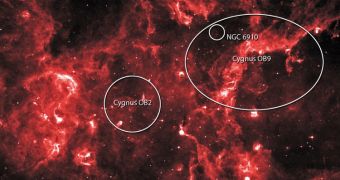According to the conclusions of a new scientific investigation conducted using the NASA Fermi Gamma-ray Space Telescope, it would appear that stellar nurseries are one of the primary sources of cosmic rays in the Universe.
These radiations are comped mainly of protons, but also other types of subatomic particles. They produce gamma-rays, the most energetic form of light, every time they strike massive hydrogen gas clouds, such as those inside star-forming areas of the Universe.
Astrophysicists have been trying to figure out where gamma-rays come from for many years, but their efforts have largely failed due to the complex nature of the search involved. Using the new study, it was possible to identify stellar nurseries as one of their origins.
For this investigation, Fermi was trained on a dark lane that splits the Milky Way in half, called the Great Rift. The formation is located in the constellation Cygnus, and contains one of the richest, most active stellar factories in the entire galaxy.
The structure was first identified in the 1950s, and has been named Cygnus X. What the new research managed was demonstrate that the area is perfectly capable of producing cosmic rays, radiations that move through space at nearly the speed of light.
Studying the origins of cosmic rays is impossible because their original paths are covered by the numerous distortions they experience as they move around the Universe. Electromagnetic fields around stars and black holes distort their direction, scrambling their origins from astronomers.
When colliding with interstellar gas, cosmic rays generate gamma-rays, which then travel on an undistorted path from their point of origin to Earth. The Fermi Large Area Telescope (LAT) instrument managed to discover such a source in the stellar factory Cygnus OB2.
The area contains large numbers of very massive stars, which weigh more than 40 times the mass of the Sun. These stars produce intense ultraviolet radiation and stellar winds, which disperse the gas around them, carving out large hollows.
Fermi managed to discover gamma-rays originating within these hollows, indicating stellar nurseries are natural sources of such radiations. Details of the study were published in the November 25 issue of the top journal Science.
“We are seeing young cosmic rays, with energies comparable to those produced by the most powerful particle accelerators on Earth,” explains one of the coauthors of the new study, Padova University physicist Luigi Tibaldo.
“They have just started their galactic voyage, zig-zagging away from their accelerator and producing gamma rays when striking gas or starlight in the cavities,” concludes the investigator, who is also based at the Italian National Institute of Nuclear Physics.

 14 DAY TRIAL //
14 DAY TRIAL //